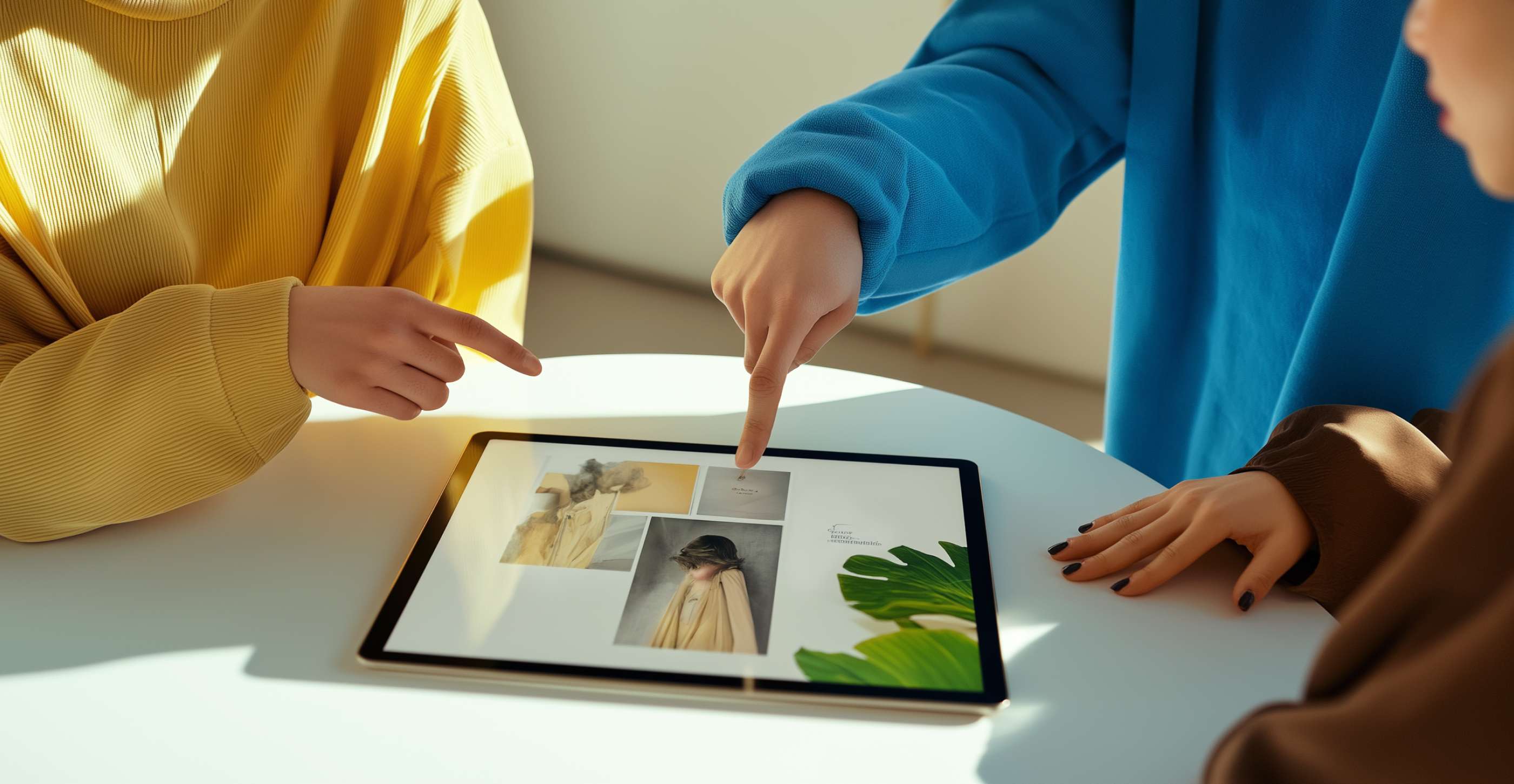8 Ways Companies Can Use Illustration Design to Stand Out

When you hear the word ‘design,’ a few different ideas may come to mind. Some people think of logos and brand identities. Others may think of packaging or posters. You can find design everywhere, from websites to social media ads to your favorite coffee mug, so it’s understandable why the concept can be a little confusing to define.
When it comes to design styles, though, illustration design seems to be having a real moment! Commonly found on websites, social media posts, ads and more, illustrations are a versatile design technique that can help brands stand out.
Different design types can have some common features, but each specialization requires a specific set of skills and design techniques. No, not every designer will be able to create custom illustrations! Nor will all designers be able to layout websites. It’s good to know the difference so you can understand what type would best suit your company’s needs, goals and overall brand identity.
In this post, we’ll break down everything you need to know about illustration design, including:
- The definition of illustration design
- The difference between illustration and graphic design
- 8 ways to use illustration design to build your brand
- 6 reasons why all businesses should use illustration design
- Why illustration design is so hot right now
What is Illustration Design?
In a nutshell, an illustration is “a visual explanation or interpretation of an idea, process or concept.” They’re most often used to help tell a story that might be hard to represent through videos or photography.
Illustration design can be literal or abstract, but they’re typically lively, character-driven visuals that convey a brand’s personality and sense of humor. Children’s book drawings are probably the most well-known illustration design examples. Still, you can also find them in branding materials such as website headers, social media posts or landing pages.
What is the Difference Between Illustration and Graphic Design?
The most significant difference between illustration and graphic design is the purpose. Graphic design solves communication problems that a client or a company has through design elements like typography and color. It’s a very broad term that can encompass many types of digital design. In contrast, illustration can help explain an idea, support a concept, or tell a story. Illustration used to be thought of as more fine art, but it has become wildly popular over the years. Illustrators have skills in drawing and often painting or sketching, which helps them to create beautiful images for a wide range of purposes, including advertising and marketing.
You can also use illustration to engage an audience and capture their attention in a way that can be hard to achieve through graphic design alone. Take this 2020 Annual Report Instagram post from Mailchimp. If you're looking to display your data like this, the best bet would be to have a designer create a visual data report for the best results.
The choice of color, typeface and layout feels fresh and exciting on their own. However, the quirky illustrations add a touch of humor and whimsy that takes things up a notch and makes the post more fun and engaging to swipe through.
Here’s 8 Ways to Use Custom Illustration Design to Build Your Brand
Stuck on how to incorporate illustration design into your company’s marketing materials or overall brand? Here are a few ideas to help get those creative juices flowing.
1. Logotypes
We know that minimal logotypes are trending right now, but adding an illustrated character to a logo can add a unique style to your brand.
Source: 99designs
2. Editorial illustrations
You can use editorials illustrations in company blogs, eBooks, newsletters, infographics, emails and social media content. They should complement your written content by capturing its tone and mood in a compelling visual.
Source: Booth Magazine
3. Icons
An icon is a symbol that represents a bigger idea. It should be something you can easily interact with and also transcend culture and language. These 3D icons are a great example of how you can use illustration to add a little twist on a more functional design asset.
Source: Behance
4. Spot illustrations
These can be illustrated UI, simple objects or simple actions. They also tend to “float” rather than be grounded in space, like this image of a hand holding a flower.
Source: Olga Kawa
5. Scene illustrations
Often used in ads and onboarding materials, scene illustrations tell the story of a single product or feature and show how it might fit into a users’ life. When used correctly, they should eliminate the need to repeat the message as often as we presently do.
Source: Ashley Michael Atherton
6. Hero illustrations
These are full-width, full-color illustrations that you’d use as a website’s hero image (i.e. the large banner section at the top of a website). Hero illustrations can be quirky and cute or more to-the-point, but they ultimately need to be captivating. The hero image is the first visual that your users will see, so it needs to communicate what you do while also enticing your audience to learn more.
Source: Tran Mau Tri Tam
7. Animated illustrations
What’s better than a beautiful illustration? One that moves. Maybe businesses will use this style of design in their social media ads and explainer videos. It’s a great way to capture attention!
Source: Katja Belkina
8. Advertising and social media
People today are bombarded with images, but using illustrations in your ads or social media posts can help you catch the eye of a potential customer better than a generic stock photo or text post. Just be sure to find a style that matches your brand.
Source: Katja Belkina
Why Should Businesses Use Illustration Design?
Slack and Mailchimp may have helped popularize the use of illustration design in marketing, but clearly, the design type has taken on a life of its own over time. We’ve compiled some of the top reasons why this is:
1. You can represent a wide range of people
Illustrations can be a great way to portray a diverse range of body types, sizes and races, without the time or resources required to set up a company photoshoot or hire diverse models and actors.
2. You can communicate abstract or complex concepts
Many tech companies often struggle to explain how their software works through words or photos alone, which is where illustration shines. You can showcase products, services or features that would be nearly impossible to capture any other way.
3. It’s (relatively) affordable
If you don’t have a ton of money to invest in branding, a pricey photoshoot may be out of reach or even impossible to do with social distancing requirements. Custom illustrations may still be a significant investment, but they’re more often easier and faster to execute or edit than custom photography or video.
4. They’re eye-catching
Every illustrator has a unique style and personality. If you find somebody whose style matches your brand’s voice and identity, their work can help make your content stand out and help build brand awareness and recognizability. That being said, great illustrators can adapt to your brand (or come up with entirely new styles) to fit the brief.
5. You can convey a lot of personality
Suppose your company’s product or service is more on the technical side. In that case, illustration can help breathe life into your marketing by helping your brand seem more fun and approachable and turning facts and figures into visually-appealing graphics.
6. You can tell a story
As mentioned earlier, illustration design is often leveraged for its storytelling. Maybe it has something to do with all of those creative children’s books many of us grew up reading. Illustration can take your audience on a journey, whether that’s walking new users through your product onboarding with illustrated scenes or characters or crafting a subtler narrative across various marketing channels.
The Need for Illustration Design will Only Increase
If you’ve stumbled across a SaaS website or new app’s homepage, then you’ve probably noticed that illustration design is having a huge moment right now. User Researcher Mitchell Wakefield even went viral for his tweet that points out how pervasive illustration design has become in the tech world, pulling together examples from multiple SaaS websites, including Airtable, Slack and Buffer.
why does every website landing page look like this now? pic.twitter.com/V4id2BwQco
— Mitchell Wakefield 🦧 (@wakefield00) February 15, 2021
Why the surge in popularity? Many designers cite illustrator and designer Alice Lee’s work with Slack in 2017 as a watershed moment for using illustration design in marketing. In a blog post on her website, Alice Lee writes that before 2017, illustration was much more “structured, blockier line-art; Bauhaus-inspired, vectorized geometry; and faux-skeuo 3D.” By 2018, she noted a significant shift towards illustration that was more “character-driven, much more narrative, lush, and colorful,” which we can see in the examples from Mitchel’s tweet above.
Describing her work with Slack, Alice says she “wanted to create an illustration voice that was totally unexpected at the time, and custom to their brand needs: warm, friendly, polished, and at times quirky.”
Source: Unbounce
Mailchimp was also a trendsetter in this arena. In 2018, they underwent a bold redesign where they traded in their more cartoon-like mascot and script font logo for a more grown-up serif font, bold banana yellow primary color and now-signature abstract illustrations.
Source: Copygrad
Source: Smb Guru
According to Mailchimp, “Our new approaches to illustration, animation, and photography allow us to communicate with a wider range of emotions, take more risks, and showcase the creativity of our artists and designers.” They also state that the illustrations are more organic and playful while still communicating a message, help them discuss complex tools and marketing practices and play with motion in unexpected ways.
Today, illustration design has become so popular that you can find illustrations on stock photo sites. There are even websites dedicated to creating illustrations featuring people of color.
Final Words
We believe that illustration is for everyone. However, just like with any new design style, you need to take a strategic approach. Otherwise, you risk adopting an illustration style that feels a little unimaginative, or worse, inauthentic. For example, if your brand personality is more on the serious side, quirky cartoons might appear off-brand to your target audience.
Our advice? To make the most of your illustration design, be sure to do your research, find an illustration partner that understands and aligns with your brand vision, and lean into what resonates best for your particular audience and industry.
You may also like these

25 best multichannel brand campaigns in 2025 for inspiration
The evidence is clear: Multichannel marketing works.In fact, recent research reveals that 95% of marketers believe that integrating multiple marketing channels in ad campaigns improves audience targeting, according to industry. Companies with strong multichannel marketing campaigns experience a 9.5% rise in annual revenue and 91% higher customer retention rates.With so many top campaigns and great ideas out there, you might be wondering what can work best for your business this year, based on marketing goals, your industry and who's able to scale as much as you need.A leading creative subscription service like Superside offers a powerful way to grow your business with speed and efficiency, as we have done with top brands and enterprises for years now.Of course, taking inspiration from others is a wise place to start. Work through this curated list of creative ad campaign examples to find ideas for your next campaign.
13 principles of design: A visual guide from Superside (2025)
Design is everywhere. It influences everything from our pyjamas to our jeans, from our cities’ layouts to our homes.But what makes a design “good?” Why do some designs attract us while others make us feel queasy? Is there a science behind the art, or is it just intuition?If you’re facing a design quandary, this comprehensive guide for enterprise design teams will give you a deeper understanding of design principles. Ultimately, it can help you enhance and elevate your visual communication, branding and marketing strategies.We cover the elements and principles of design, and include clear graphic design examples to illustrate these concepts.Grab that coffee. It’s time for a design deep dive.
15 Corporate Presentation Design Ideas & Services for 2025
Compelling presentations are deal-makers: They captivate audiences and drive decisive outcomes.In fact, the visual storytelling research is pretty convincing. 85% of people remember what they observed in a presentation three hours later, compared to 70% who recall what they heard. After three days, 60% remember the images, but only 10% remember the spoken content.Your presentations must be first-rate. They should simplify complex ideas, showcase information in an easy-to-grasp way, and tell persuasive stories.As an industry leader in corporate presentation design, Superside combines innovative tools, creative expertise and strategic thinking to craft professional visual stories for customers worldwide.You'll find the info on this page invaluable if you’re looking for the best enterprise presentation design service. Superside’s team shares a few killer corporate presentation design ideas to help you lift your game.







